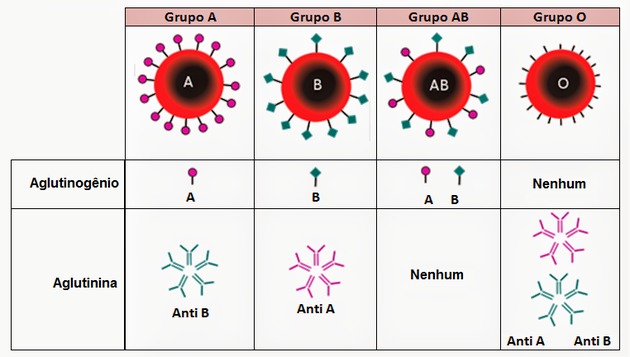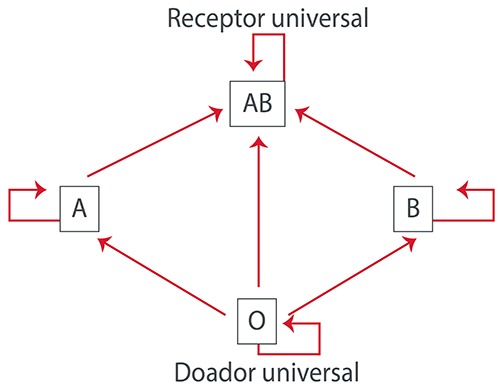The ABO System represents an important blood group in determining compatibility between blood types.
The discovery of the ABO system took place in 1901 and is due to the physician Karl Landsteiner (1868 – 1943). He and his team realized that when some types of blood were mixed, red blood cells clumped together, which is called blood incompatibility.
Thus, it was found that there were some blood types, which were called A, B, AB and O. Hence the ABO system.
The determination of blood types is a genetic condition, constituting a case of multiple alleles, determined by three alleles: I A , I B , i.
Blood types
There are four types of blood: A, B, AB and O. Each of them is determined by the presence or absence of agglutinogens and agglutinins:
- Agglutinogens are antigens found on the surface of red blood cells . There are two types of agglutinogens: A and B.
- Agglutinins are antibodies present in blood plasma and come in two types: anti-A and anti-B.

Blood transfusions
Agglutinins react with antigens, hence the importance of recognizing blood types at the time of a transfusion. For it to occur correctly, there must be compatibility between the donor’s red blood cells and the recipient’s plasma, that is, agglutinins must not react against agglutinogens.
Blood incompatibility in cases of transfusions causes red blood cells to clump together, that is, clusters are formed as if they were clots. This situation results in the clogging of blood capillaries, compromising blood circulation.
For example, a person with type A blood when donating blood to another type B person causes the red blood cells to agglutinate due to the presence of anti-A.
The same happens in an individual with type B blood, he has red blood cells with B antigens and anti-A antibodies, rejecting type A blood.

Blood incompatibility is considered serious and can lead to serious health complications and even death. Therefore, a person who received a blood type incompatible with yours during a transfusion should receive immediate medical attention.
Exercises
Take the opportunity to test your knowledge of the ABO System, practice the exercises below:
1. (Vunesp) Transfusion of type B blood to a person in group A would result in:
a) reaction of anti – B antibodies of the recipient with the donor red blood cells.
b) reaction of the recipient ‘s B antigens with the donor’ s anti – B antibodies.
c) formation of anti – A and anti – B antibodies by the receptor,
d) no reaction, because A is a universal receptor.
e) reaction of anti – B antibody from the donor with A antigens from the recipient.
Answer
Alternative a) reaction of anti – B antibodies of the recipient with the donor red blood cells.
Comment: In this case, the anti-B antibodies of blood A would react against the agglutinins of blood B, that is, the donated blood. Remember that this is due to blood incompatibility and will result in red blood cells clumping together.
2. (UNIFOR– 2001.2) In the human species, the alleles that determine blood type A (I A ) and type B (I B ) are co-dominant. These two alleles, however, are dominant over the allele responsible for type O (i) blood. Thus, if a woman with blood type A has a child with blood type B, the blood of the child’s father can be of the type:
a) B or O
b) A, B, AB or O
c) AB or B
d) A or B
e) A, B or AB
Answer
Alternative c) AB or B
Comment: The mother has genotype I A i, as she had a child with blood type B (I B i), the child’s father can only have the possible genotypes (I A I B or I B I B ).
3. (UEPB-2006) Two patients in a hospital have the following blood characteristics:
PATIENT 1: has both Anti-A and Anti-B antibodies in their blood. PATIENT 2: has no Anti-A or Anti-B antibodies in the blood. It can be stated that:
a) patient 2 is a universal donor type.
b) patient 1 can receive blood from patient 2.
c) patient 1 can only receive blood A.
d) patient 2 can only receive blood AB.
e) patient 2 can receive blood A, B, AB or O
Answer
Alternative e) patient 2 can receive blood A, B, AB or O.
Comment: Patient 1 has type O blood and patient 2 has type AB blood. Therefore, type AB is a universal receptor and can receive all blood types. To share Submit Email
